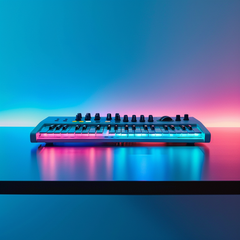How to Get the Groove in Your Productions?
Groove is the secret ingredient that makes Tech House tracks irresistible on the dancefloor. While rhythm and swing are key components, there’s another often-overlooked trick to enhance groove: filling the frequency spectrum between 200 Hz and 400 Hz. This range plays a critical role in adding body and movement to your track.
In this tutorial, we’ll reveal a clever technique using Ableton Live to create a dynamic groove by combining pads and percussion with the Vocoder effect. Let’s dive in!
Why 200 Hz to 400 Hz?
This frequency range is where much of the "body" of a track lives. It’s not as low as the sub-bass or as high as the crispy tops, but it provides warmth, richness, and groove. By filling this area creatively, you can make your track feel fuller and more rhythmic without overpowering other elements.
Step-by-Step Guide: Adding Groove with Vocoder in Ableton Live
Step 1: Start with a Pad
- Load a pad sound on a MIDI or Audio track in Ableton Live. Choose a pad with some movement or harmonic richness to make the effect more dynamic.
- Play a sustained chord or note that fits your track’s key. Adjust its level so it doesn’t overpower your mix.
Step 2: Add a Top Loop or Percussion
- On a new audio track, load a Top Loop or Percussion Loop. This could be anything with rhythmic complexity, like hi-hats, shakers, or congas.
- Ensure the loop has enough energy to cut through but doesn’t dominate the mix.
Step 3: Insert the Vocoder
- On the Top Loop track, load the Ableton Stock Vocoder plugin.
- In the Vocoder’s settings, set the Carrier to External.
- Choose the Pad Track as the external input source. Now, the top loop will be modulated by the pad’s harmonics.
Step 4: Mute the Pad Track
- Mute the Pad Track so it doesn’t play directly in the mix. Its harmonic content will still drive the Vocoder on the Top Loop track.
Step 5: Isolate the Frequency Range
- After the Vocoder, add an EQ Eight to the Top Loop track.
- Use the EQ to cut everything outside the 200 Hz to 400 Hz range.
- Use a low-cut filter around 200 Hz.
- Use a high-cut filter around 400 Hz.
This isolates the groove-enhancing frequencies, ensuring the modulation doesn’t interfere with other parts of the mix.
Step 6: Adjust the Vocoder and EQ Settings
- Fine-tune the Vocoder’s Bandwidth and Release parameters to achieve the desired groove.
- Use the EQ to ensure the effect fills the frequency range without clashing with the kick or bass.
Why This Trick Works
This technique uses harmonic modulation to create subtle movement in the 200 Hz to 400 Hz range. The interaction between the pad and the top loop introduces a rhythmic, groove-enhancing element that wouldn’t exist otherwise. By isolating this range with an EQ, you ensure the groove sits neatly in the mix without overcrowding other elements.
Pro Tips for Maximum Groove
- Layer Multiple Loops: Experiment with layering different percussion loops to add complexity. Each can use the same Vocoder technique for a richer effect.
- Automate Parameters: Add automation to the Vocoder’s release or EQ bands to introduce dynamic changes throughout your track.
- Add Sidechain Compression: Apply sidechain compression to the Top Loop track, ducking it against the kick to maintain punch and clarity.
- Experiment with Other Carriers: Try using different harmonic sources, like a vocal sample or lead synth, as the external input for the Vocoder.









